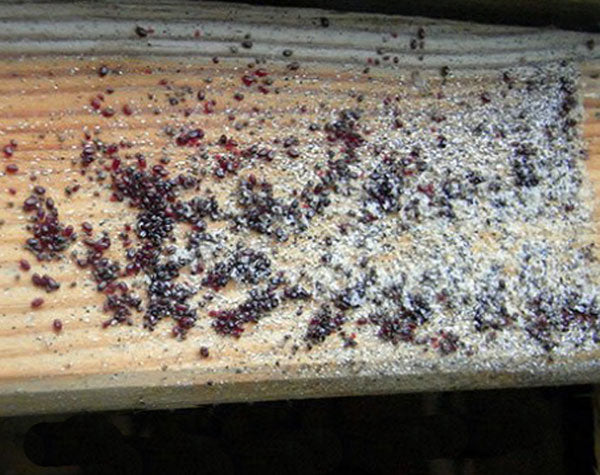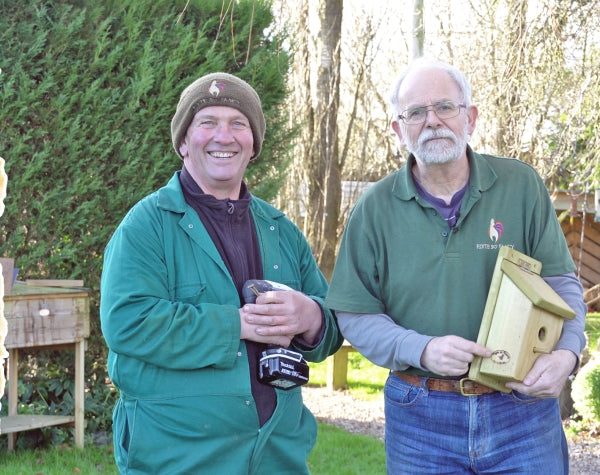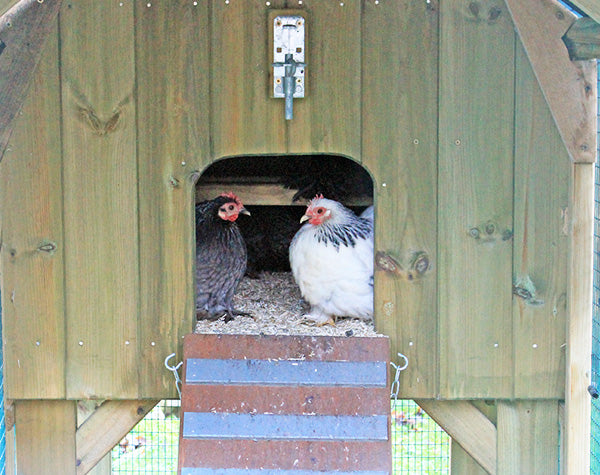How to get rid of Red Mite in Chicken Coops
What are red mites?

Red Mites are small parasites that live in your chicken coop and feed on birds whilst they sleep at night (not to be confused with Red Spider Mite, a harmless garden bug).
These small but deadly blood-sucking mites feed on all parts of the chicken including feathers, skin and scales.
They really are the things of chicken nightmares!
Red Mite infestations in a poultry house can result in poor health of the birds, low egg production, weight loss and, in bad infestations, even death of the bird.
For an easy to read list of signs to look for see our blog The 9 Signs of Red Mite in your Coop.
As our climate has changed, and our method of keeping poultry, so the instances of Red Mite have rocketed over the last decade or so. However, with vigilance, good husbandry, and the right products, this need not be the nightmare it at first appears.
Life Cycle of Red Mite
Red Mites crawl out of their hiding places and feed on the birds between one and two hours each night. They don't like daylight and live in cracks and crevices in the hen house as this is where they deposit their eggs.
When the nest conditions are correct the mite larvae hatch 2-3 days after being laid. The time it takes for a mite to go from egg to egg-laying adult is 7 days. This short cycle can cause Red Mite infestations to grow very rapidly. Even without a food source Red Mite can survive for as long as 9 months or more, making them a very hardy pest.
Constant checking is needed during warm weather but we also advise that you should continue with a cleaning product like Flyte Mite Ready-to-Use Spray and a liberal sprinkling of Diatomaceous Earth Powder throughout the winter as well.
Spotting the Red Mite signs
 An initial telltale sign of infestation may be the reluctance of the hens to go into the house at night.
An initial telltale sign of infestation may be the reluctance of the hens to go into the house at night.Your birds may start to look anaemic and lethargic i.e. pale combs rather than red, and they may sit hunched up in a corner rather than actively scratching around.
The best time to check for Red Mites is early morning when they can be seen easily by the naked eye or with a torch. After feeding on the blood of the birds overnight, the mites will get their distinctive dark red colouring.
Another telltale sign is a build-up of a grey dust in the coop, this is the detritus from the mite. Look particularly under perches and in perch sockets for live mites. The mites can also be found hiding in the grey dust on the floor and in the timber joints.
Take a look at our AskPhill Video all about Red Mite - How to get rid of Red Mite.
Red Mite eradication
If you are already suffering from a Red Mite infestation here are some ideal 100% natural, non-toxic products.

Smite Red Mite Liquid is a concentrate that you mix with water (e.g. 1 litre makes up to 34 litres). It is a non-toxic biocidal detergent and degreaser that is best applied to your chicken coop with a pressure sprayer. It works by breaking down organic matter and eradicating the red mites' habitat.
Apply the solution throughout the coop, letting it seep into every crack and crevice to disinfect and degrease, then scrub to remove debris. Safe for use on all animal and bird housing.

We recommend, as part of a two-prong operation, that you follow the cleaning with Flyte Diatomaceous Powder or Smite DE when dry. DE is powdered Diatoms (fossilised algae) with a crystalline structure that are highly abrasive on the mites’ waxy shell.
As the mites crawl through the powder it scatches their shell, they dehydrate and die. It is a natural product so they cannot build up any resistance. Sprinkle throughout the house wherever the mite may hide. Pay particular attention to perches and nest boxes to kill any remaining mites.
You would likely have to repeat this process every 6 days until you are sure they are eradicated. Using a Powder Shaker/Duster will make it easy to apply in the coop.
Diatomaceous Earth Powder can also be applied directly onto the bird (not near the eyes) which helps them get some relief. Again, as the mites come into contact with the powder, it will cut their waxy shells. Use a spinkler/duster or the DE Puffer Pack to make application less disturbing for the birds and to reach through the feathers to the skin.

We have made a small kit of several products to help with the battle as well as help the birds recover. Try our Anti-Red Mite Kit.
Quick Killer Solutions
There are also Permethrin insecticide based powders like Battles Red Mite Powder and Net-Tex Total Mite Kill Liquid is a particular favourite of many chicken keepers.
Nettex also do an aerosol version of Total Mite Kill which makes it very easy to apply inside the coop. As with all powders and sprays we recommend using gloves and a mask.
There are many other products on the market to fight the Red Mite battle. We have Smoke Bomb Fumers, as well as cypermethrin based answers like Ardap Insecticide Aerosol. Please take a look in our Red Mite Eradication Section to find more products or call us if you need further advice.
Red Mite Prevention
Apart from Smite Liquid and DE mentioned above, as a preventative measure, you could also use Barrier Red Mite Powder on the birds.

Barrier Red Mite Powder is an organic insect repellent for use against red mite. It contains a tea tree oil repellent. Apply directly to poultry and sprinkle liberally in the housing too.
Follow any Red Mite Treatment with Stalosan F, a powder disinfectant that destroys worm eggs, coccidial oocysts & larvae (note: does not kill red mite directly). With anti-bacterial, anti-fungal, anti-viral action, Stalosan is highly absorbent and will help to reduce the ammonia smell created by the chicken's droppings as well as make the henhouse an inhospitable place for mites.
If your birds are showing signs of anaemia or are looking unwell then give them a vitamin and iron boost with Agrivite Red Mite Rescue Remedy to rebuild their iron balance.

Using a chopped Hemp Bedding in the henhouse can also help because, unlike straw, it does not provide hidey holes for the mite. Straw, being tubular in nature, will allow the mite to hide and avoid being seen.
Always burn any old bedding that you think might be infested. We have found our Chopped Hemp Bedding with Eucalyptus very popular, which anecdotally keeps red mite away. Hemp Bedding is far easier to keep clean so will avoid the build-up of matter where the mite can thrive. Eucalyptus is also antibacterial and red mite find it 'most unpleasant'.
To help prevent your birds being subject to these blood-suckers there is also an Oblitermite Tonic available. You can give it to your birds in their drinking water and it helps them cope with any infestation (it makes them distasteful to mites). Note, it doesn't necessarily stop red mite infesting the coop, but it helps to prevent the birds being plagued by them.
You may see many promotions stating that plastic henhouses prevent red mite, or cannot be infested, but we would have to say that in our experience this is not the case.
Plastic, or metal, hen houses are just as likely to get red mite infestations as timber houses albeit they are easier to spot and have less hidey-holes. Plus, as some are more prone to condensation, and have poor ventilation, this creates a humid environment which red mite love.
It's all a matter of how many places there are for the mite to hide but, most of all, it is about spotting the signs early and treating any problems straight away.
Red Mite facts ...
- Red Mite do not live on humans but can produce a form of dermatitis if not washed off as soon as possible.
- Red Mites hate daylight.
- Mites transmit or can cause Rickettsial Pox, Scrub typhus, Mange, Scabies, Dermatitis, Pruritis, Tsutsugamushi disease and other diseases.
- Poultry Red Mite only attacks domestic poultry and pigeons/wild birds.
- Poultry Red Mite can survive for up to 8 months between blood feeds.
- A Red Mite is about 0.7mm long with an oval body and is normally yellowish-brown in colour (before feasting).
- Red Mite can live in plastic chicken houses just as readily as in timber houses, it's just there are less places to hide.
Are you ready for them?
I hope this information helps when treating what is a relatively common problem for poultry. With vigilance, the right treatment and some preventative actions your chicken coop can be red mite free and your chickens will be happy.
- - - -
Red Mite in Chicken Houses ©Flyte so Fancy 2010. Updated 2020. Author: Anne Weymouth (Director, Flyte so Fancy Ltd). Reproduction of part or all of this text is only possible with the express permission of Flyte so Fancy Ltd.



